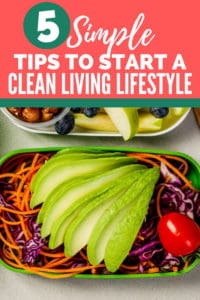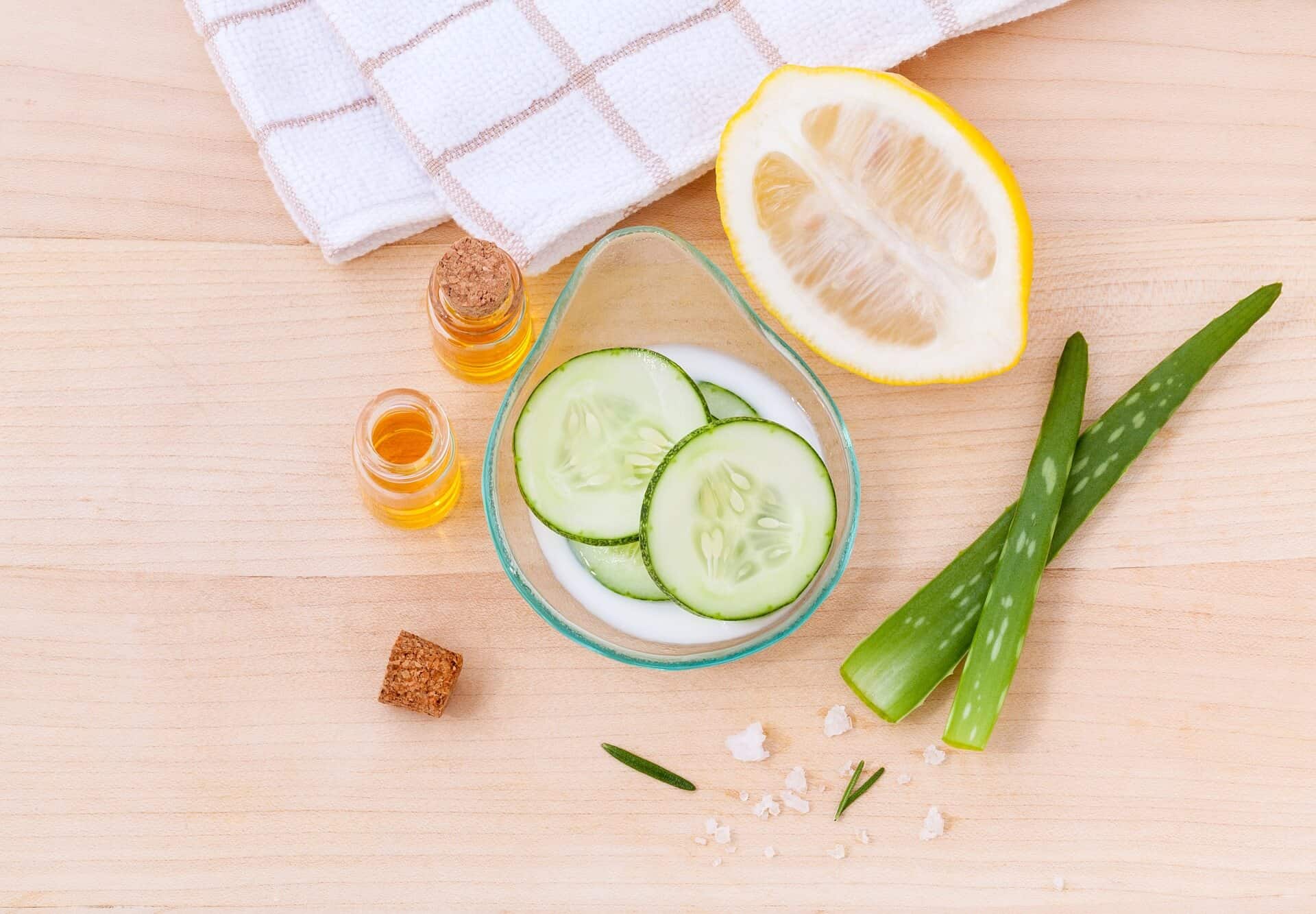I’m excited to introduce my friend Rebekah today. She is the founder of Simply Living Green with Rebekah and has put together some awesome information for us about starting a clean living lifestyle. Her blog posts are always so interesting and thorough, I know you will love it! Thanks, Rebekah!
Did you know that adopting a clean living lifestyle could rid your body of hundreds of toxins?
It’s true that we are all exposed to hundreds of harsh chemicals and toxins in so many ways – personal care products, cleaning products, food, and even your makeup.
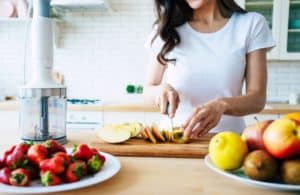 So imagine how you would feel if you could clean up your lifestyle and drastically reduce your exposure to these toxins. With these 5 simple tips, even the busiest of women can achieve that goal and start living a clean lifestyle.
So imagine how you would feel if you could clean up your lifestyle and drastically reduce your exposure to these toxins. With these 5 simple tips, even the busiest of women can achieve that goal and start living a clean lifestyle.
How it Can Impact Your Heath
My family set out on this journey when my daughters were young and they had some pretty severe allergies and sensitivities to body products and cleaning products – including laundry detergent. It was so severe for them that when family members held our baby girls at parties, they would break out in allergic rashes, and eczema, and experience flushing.
Unfortunately, the perfumes, laundry detergents, and fabric softeners that our friends and family were using were causing the allergic reaction and skin sensitivities. So we had to find a way to not only protect our daughters at home but also when we were out and about.
I began to look for safer alternatives and started researching what was causing these allergic reactions. The more I learned, the more I realized that we needed to change the products were using.
I started looking for laundry detergents that were safer for our girls. I checked out the shelves at our favorite local store and bought a container of name-brand unscented laundry detergent. I mistakenly thought back then that “unscented” or “free and clear” meant that all that harmful junk was omitted.
We did see some improvement in the girls’ skin and reactions, but as I learned more about shampoo, body wash, and cleaning products, I realized I needed to start purchasing more natural versions – or green products.
Our local store had a variety of “natural” brands and even some of the more popular cleaning product brands had “green” versions popping up. I bought the products at face value. I didn’t really look at the ingredients because I trusted that these products were “natural” and “green”.
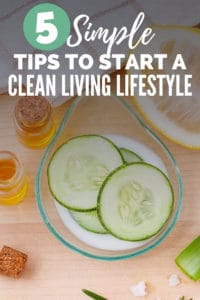 Boy was I wrong! I eventually learned about greenwashing. Greenwashing is a marketing spin where companies can lead you to believe that their products are more natural and safer, even if it is not true. There is very little regulation over the labeling of these products, and it is more important for you to look at the actual ingredients included on the label – not the claims made on the front of the bottle.
Boy was I wrong! I eventually learned about greenwashing. Greenwashing is a marketing spin where companies can lead you to believe that their products are more natural and safer, even if it is not true. There is very little regulation over the labeling of these products, and it is more important for you to look at the actual ingredients included on the label – not the claims made on the front of the bottle.
Additionally, I was shocked to discover that even laundry detergents that were “unscented” still contained fragrance on their ingredient list. So while you don’t “smell” the fragrance it is still there to mask the other scents of the ingredients in that product.
So you may wonder, is fragrance harmful and why did our family start avoiding it?
We started avoiding fragrance in our products because “fragrance” is a blend of up to 4,000 undisclosed chemicals. Many of these chemicals are linked to health harm. Companies are required to disclose their ingredients under the Fair Packaging and Labeling Act Of 1967, but the “fragrance loophole” protects them from disclosing the proprietary blend of ingredients in their fragrance since it is a trade secret.
Unfortunately, this only protects the companies – not the consumers. How can consumers avoid potential health harm, such as allergies, asthma and other diseases, if the ingredients are not disclosed to the public?
Other Health Impacts
Even if you don’t have allergies or skin sensitivities, there are other reasons you will want to swap out your cleaning products, beauty products, and other harmful toxins, such as fragrance. Many chemicals found in our everyday grocery store products are linked to endocrine disruption, infertility, and even cancer.
Many of us have family or friends who have received the dreaded cancer diagnosis or have struggled with fertility problems. I have several close family members and friends on these difficult journeys.
While we don’t always stop to analyze why we are having these health problems, I would urge you to take a closer look at what you are putting in and on your body. A good friend of mine did stop to consider what changes she could make to her lifestyle to protect her health after overcoming a battle with cancer.
Tiffanny remembers, “After the initial shock, denial, and sadness, came searching. I would spend nights when I couldn’t sleep just searching, reading, and questioning how it happened. I never really knew what I was looking for, just reading support group posts and trying to come to terms with my new reality. I wasn’t going to have any more children. We knew we weren’t planning on anymore, but to have the choice taken away from me was pretty rough. I needed to be in control. That control came with what I was putting in my body. We started eating better, becoming more aware of labels like organic and natural.”
Tiffanny fought to get healthy and to prevent this from happening again by taking a hard look at the products that she used in her home and on her body. She dug deep into the research to find out what she could do differently moving forward and how she could also protect her family.
While she and I had different reasons for working towards a clean lifestyle, we ended up in the same place. We are on a similar journey now and focus every day on how we can drastically reduce our body burden.
What is Body Burden?
Body burden is a term used to define the harmful chemical buildup in your body. Toxic chemicals can enter your body in many ways, including through the food you eat, the water you drink, the air you breathe, and what you put on your skin.
While we probably can’t eliminate our exposure to all chemicals, we can drastically reduce it and improve our quality of life.
Benefits of Clean Living
As you can see from the personal stories I shared, protecting your health is an obvious and very important benefit of a clean living lifestyle, but there are other benefits.
- Increased energy levels
- Better sleep
- Improved mood
- Increased immunity
- Increased fertility
- Decreased risk of endocrine disruption
- Decreased body burden
5 Clean Living Tips
Just imagine how you would feel if you could reduce these harmful chemicals and start realizing these benefits right away. With 5 simple clean living tips, you can achieve this goal, protect the health of you and your family, and start living a clean living lifestyle today.
Clean Living Tip #1: Swap your Household Cleaners
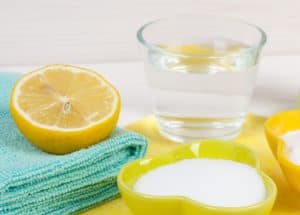
One way to avoid these harmful ingredients is to swap out your household cleaners for more natural and eco-friendly options.
Like Darcy discussed in her post about tips for a chemical-free home, I have swapped out my traditional chemical cleaners for safer alternatives. I encourage you to try one (or several) of these tips for safe, natural cleaning options.
- Switch to Microfiber – High-quality microfiber cloths, such as Norwex, are an easy, safe, and non-toxic way to clean your home without any chemicals at all – just water! This will not only save you time and money, but it also creates a lot less waste since the microfiber cloths last for years and replace the need for cleaning solutions and paper towels.
- Make Your Own DIY, Natural Cleaning Solutions – While I mainly use microfiber cloths and water to clean my home, some people prefer to use a cleaning solution for more stubborn stains and situations. An effective and safe option is to use vinegar, baking soda, lemon juice, fragrance-free liquid soap, and add in essential oils if you prefer a pleasant scent.
- Read Labels and Research Ingredients – If you do decide to purchase store-bought cleaning products, do your research and know what ingredients to avoid. The Environmental Working Group (EWG) has a great website with information on safer cleaning options. Even better, you can download their Healthy Living app to your smartphone and have with when you are shopping. You can look up safe products and research specific ingredients to see their safety rating. This tool is invaluable!
Clean Living Tip #2: Clean Up your Beauty & Personal Care
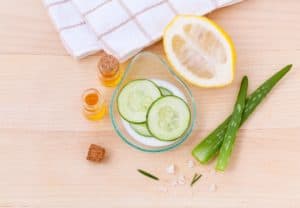 Did you know that according to the EWG, “the average woman uses 12 products containing 168 unique ingredients every day?” That’s a lot of ingredients! Your risk of health harm is greater when you use more products.
Did you know that according to the EWG, “the average woman uses 12 products containing 168 unique ingredients every day?” That’s a lot of ingredients! Your risk of health harm is greater when you use more products.
- Reduce Your Personal Care Products – The first thing you can do is reduce the number of products you put on your body – makeup, body lotion, soap, body wash, and such. Streamline your beauty routine as much as possible.
- Avoid ALL Products with Fragrance – The ingredient “fragrance” is actually a blend of ingredients and can contain up to 4,000 undisclosed ingredients, including harmful toxins such as phthalates, according to the EWG. Many of the chemicals used to make fragrances are can cause endocrine disruption, asthma, and even cancer, and should be avoided completely.
- Buy from Trusted Companies – While it is possible to make your own beauty products, I have to admit that I haven’t tackled that goal quite yet. Instead, I shop from trusted brands, such as Beautycounter and others that I find on the EWG Skin Deep website and their Healthy Living app. Darcy also recommends Monat for their naturally-based, anti-aging haircare and skincare products.
- Consult Beautycounter’s Never List – Beautycounter’s The Never List includes more than 1,500 questionable or harmful chemicals that they never use as ingredients in their products, including banned or restricted chemicals by the European Union. Visit Beautycounter’s website to learn more and print a copy of The Never List to take with you when you are shopping for beauty and skincare products.
Clean Living Tip #3: Choose Safe Cookware
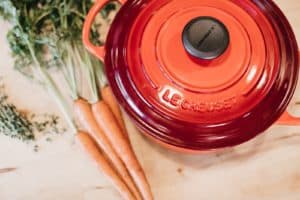 Many of us grew up using non-stick cookware, such as Teflon, stain-resistant fabrics, and other non-stick products. These products promised convenience and the ability to save us time and money. But did you know that almost every human, including newborn babies, has Teflon chemicals in their blood?
Many of us grew up using non-stick cookware, such as Teflon, stain-resistant fabrics, and other non-stick products. These products promised convenience and the ability to save us time and money. But did you know that almost every human, including newborn babies, has Teflon chemicals in their blood?
According to the EWG, for over 50 years, DuPont and 3M have been manufacturing and using toxic chemicals to make Teflon and other products while hiding the harmful effects that these chemicals can have on human health.
I shared my research about these harmful chemicals in a recent post, Is Teflon Safe to Use? However, the bottom line is to avoid this toxic product and other similar products at all costs.
Instead, purchase and cook with any of the following safe cookware options.
- Cast iron cookware
- Ceramic cookware, such as Xtrema
- Stoneware
- Corningware and Glass Cookware
- Stainless Steel Cookware
Clean Living Tip #4: Avoid Plastic Food Storage & Food in Tin Cans
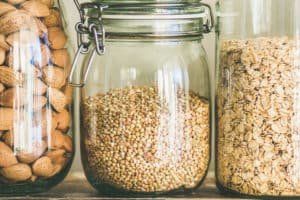 By now, most of us have heard about the dangers of BPA (bisphenol A) and how its hormone-disrupting chemicals can mimic estrogen in our bodies. This can affect brain development, disrupt your hormones, and have a negative impact on fertility.
By now, most of us have heard about the dangers of BPA (bisphenol A) and how its hormone-disrupting chemicals can mimic estrogen in our bodies. This can affect brain development, disrupt your hormones, and have a negative impact on fertility.
For starters, avoid any plastic containers and food that comes in tin cans containing BPA. Read the labels to be sure, but the question then becomes are the BPA-free alternatives safe?
The EWG and a study by the University of Texas both discovered that the BPA alternatives can be just as harmful or even worse for your health. Therefore, there is a strong reason to believe that we should avoid all plastic food storage products, avoid tin-canned food, never microwave food in plastic containers (since heating plastic expedites the release of these chemicals) and start looking for safer alternatives.
If you’re like me, that may seem pretty overwhelming. So start with one swap first, such as replacing your plastic food storage containers with glass alternatives. Then check out this FREE shopping guide to healthy alternatives to plastic for some more recommendations. Also, you may enjoy Darcy’s post about getting started with food preservation (in glass jars)!
Clean Living Tip #5: Clean Eating – How to Get Started
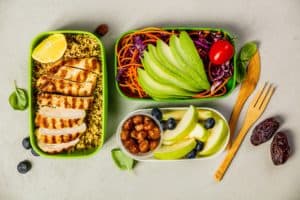
There are several definitions for clean eating, but most people I chat with about this topic agree that clean eating consists of eating whole, unprocessed, nutrient-rich foods – most of the time.
It may be difficult to accomplish this 100% of the time or for beginners to totally revamp their meal plans overnight. However, you can start working towards this goal and include more of these foods more often.
Clean eating means eating foods in their whole form as much as possible. This would include fruits, vegetables, healthy proteins, high-quality carbs like sweet potatoes, and healthy fats like avocados and nuts.
Here are a few tips to get you started.
- Avoid processed foods and artificial ingredients, as much as possible.
- Incorporate more whole fruits and vegetables into every meal.
- Try adding a green smoothie to your daily meals, such as at breakfast or mid-afternoon snack. Here’s an easy 5-Day Green Smoothie Challenge to get you started.
- Buy organic food whenever possible.
- Avoid highly processed foods with long lists of ingredients. If purchasing packaged foods, choose items that have 5 ingredients or less. Plus, make sure the ingredients are ones that you recognize and can pronounce.
Enjoy the Clean Living Lifestyle Benefits
Transitioning to a clean living lifestyle is a journey, not a destination. It will take time to slowly add in these new habits and practices. Try making one change at a time and build on your successes. Give yourself grace and time as you work towards your goals.
Over time and one swap at a time, you will be encouraged as you see the numerous benefits of a clean living lifestyle. I can’t wait for you to enjoy the increased energy and immunity, better sleep and mood, and be confident that you are protecting the health of you and your family.
About the Author
 Rebekah Lara is the founder of Simply Living Green with Rebekah and writes about going green and living clean. As a mother of three daughters with special needs, she knows what it’s like to live a hectic life and is passionate about helping busy women find simple ways to make healthy changes.
Rebekah Lara is the founder of Simply Living Green with Rebekah and writes about going green and living clean. As a mother of three daughters with special needs, she knows what it’s like to live a hectic life and is passionate about helping busy women find simple ways to make healthy changes.
